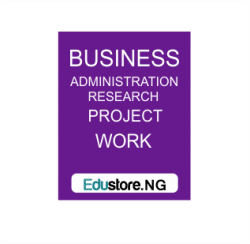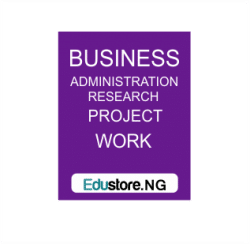ABSTRACT
This research examined the Impact of Technological Change on Organizational Success with special reference to Multichem Industrial Limited. The research adopted survey research design. Data were gathered through primary source with the aid of a well-structured questionnaire. Simple random sampling technique was adopted in the selection of sample, this was used to eliminate biasness in the selection process of the respondents.
Data garnered were presented on table using percentage and the formulated hypotheses were analysed with the used of Chi-square statistical method. The result of the analysis shows that advanced technology will significantly enhance employees’ performance. Also, the way people behave in the organization will significantly depend on the type of technology adopted. The success of technological change in a manufacturing sector depends on the know-how of the employees. And finally, the effectiveness and efficiency of any company depend on the quality of its technological inputs
Based on the conclusion of the analysis recommendations were proffered to the staff and management of Multichem Industrial Limited.
CHAPTER ONE
1.0GENERAL INTRODUCTION
The only constant phenomenon is change. This is most instructive to industrial manager who have been forced to operate in an environment where an avalanche of change is taking place.
Globalization and economic recession which the world is experiencing have made the need for a more innovation and cost effective sources of doing business.
Change is inevitable, pervasive and permanent feature of all organization. Technological change has been the key to the success of many organizations of the twenty-first century and the cause of failure of numerous others. From the time immemorial, industrial revolution ushered in an era of factory system. A system where machines were used to replace crude manpower.
Sophisticated technology has brought in new innovations and more powerful machines in swift response to the challenges posed by constant change. Technological change has led to the invention of assembly line, flow line production system, Henry Ford was reputed to bring monumental development and changes to production process. The most innovatory aspects of the moving mechanized assembly line.
Many successful organization today particularly the multinational company. (MNCS) are evidence of positive impact of advanced technology. Technology is an engine of growth which must be embraced by organization who wishes to complete effectively in the global completive market.
Organizations do not just embark on technological change. Organizations have reasons for investing into new technology. The rationale for technological change are:-
PRODUCTIVITY
Technology is a key resources and an important factor in increasing productivity. This is confirmed by the research of Haye and Clark (1995). They studied that factors that account for differences in productivity among factories. Therefore to be able to eliminate bottlenecks in productivity and sustain the level of productivity, organizations must embark on technological change.
COMPETITIVENESS
The high degree of global competition as a result of globalization and deregulation of the world economy. It has made the need for organizations to be on their toes. Technological change enables organizations to complete effectively in the global market. Organizations that fail to adopt new technology will face the daunting challenges of competitive arena.
QUALITY CONTROL
In swift response to the challenges emanating from the environment, organizations are forced to produce standardized and quality products. This is only achievable with the use of technology which makes quality of products to be controlled. For example, computer Aided Design (CAD) and Auto-CAD have brought in precision to production processes.
Another rationale for technological change is cost control and elimination waste. Advanced technology is the cost effective way of doing business. Computer-controlled production process eliminate lengthy set-up removing the bottlenecks and helping to divided output.
EFFECTIVENESS AND EFFICIENCY
Organization adopts technology to function effectively and efficiently. The needs of the customer are promptly attended to. To achieve effectiveness and efficiency, organization adopt technological change as a panacea to organization and operational inefficiency.
The successful operation of multinational company is contingent upon the availability of technology, technical know-how and the Human resources. More recently, most organizations are using micro-electronics to revolutionize significantly the nature of work and employment conditions for staff. Technological changes has also typically resulted into flatter organizational pyramid with fewer levels of management required.
The issue of technological change and its attendant effects son the organization have long been a matter of consideration and the more recent development in the field of electronics and information technology (IT) are of great excitement to imagination and hence invites speculations.
1.1 STATEMENT OF THE PROBLEMS
Technological change has resulted into re-organization of work and production processes. In the early days of factory system, organizations were highly labour intensive. Operations were carried out but human element but with the invention of new technology, there is a shift always from orthodox system and organization’s activities become machine intensive. Hence, many organizations embarked on technological change in swift response to the dictate of the time and environment.
Advanced technology such as computer has brought in flexibility to work organization and makes works easier and faster. Essentially, it brings high degree of operational efficiency and new patterns of work organization.
The problem of this study is the implication of technological change in spite of benefits to the organization. Its adoption has human and social related consequences. Organizational change is often resisted, thus resistance from employees and client could precipitate into problem.
Elimination of existing jobs is another problem. Employees that are not multi-skilled the risk of bring retrenched. This makes labour unions resist computerization as a result of displacement of members from there jobs especially secretaries and employees that are not computer literate or technologically inclined.
Another problem of this research work is that technological change creates low morale, confusion and frustration among workers and can seriously damage credibility of the management.
Industrial accident is another problem of this study. Installing new technology without proper training the workforce can lead to a negative effect.
Also failure to match technological change to the concomitant human and social considerations means that staff may become resentful, suspicious and defensive. Their uncertainties and fear may result in a reluctance to accept change.
However, psychological and social implications of technical change such, as information technology and increase automation must not be underestimated. New ideas and innovations should not be seen by staff by threats. Managers have to balance the need for adaptability and meeting opportunities by new technology with an atmosphere of stability and concern for the interests of staff.
1.2OBJECTIVE OF THE STUDY
The study, apart from aiming at adding to the scanty available works on technological change in Nigeria, skill has the following objectives:
a. To examine reasons for organizational change
b. To examine the problem emanating from the change in organization
c. To identify manpower consequent to adoption of automation technology and find solutions to them.
d. To determine the effects of technology change on the workers and their unions.
e. To determine the cost and benefits of advanced technology over orthodox system.
1.3SIGNIFICANCE OF STUDY
The Human Relations movement believes that change is inevitable feature of all organization. Therefore, the study seeks to avail captains of industries, entrepreneurs, Human resources practitioners the opportunity to be coconscious of the benefits of advanced technology in achieving organizational success.
The study is significant, because it will add to the body of knowledge in industrial setting and will enrich academic world on the more recent development in the field of technology.
1.4 SCOPE OF THE STUDY
The research work focuses on technology change and its impact on organizational success. The scope covers the impact of technological change on organizational success as it affects Multichem Industries Limited.
This research work covers basic concept of technological development, process and application. The scope focuses on the use of automation, heavy machines and computers.
1.5 LIMITATION OF THE STUDY
This study is not complete without its flaw. Some constraints encountered in the course of this research work are:-
v There was paucity of textbook to use in carrying out the research work.
v Another one is the lack of adequate fund as the study requires internet browning which is money consuming.
1.6RESEARCH HYPOTHESIS
With regards to the purpose and problems of the study, the hypothesis to be tested in the study are:-
a) Advanced technology will significantly enhance employees’ performance.
b) The way people behave in the organization will significantly depend on the type of technology adopted.
c) The success of technological change in a manufacturing sector depends on the know-how of the employees.
d) The effectiveness and efficiency of any company depend on the quality of its technological inputs
1.7HISTORICAL BACKGROUND
The company belongs to Tolaram Group of company (The group’s headquarter in Nigeria is at Osborne Road, Ikoyi, Lagos, Nigeria. The International headquarter is in Singapore (Asia) with other subsidiaries spread across the globe.
At inception the company been with 140 employees and by 1999, the branches had reached six with the strength of seven hundred and one (701).
MIL dealt with only Textile Auxiliaries Chemicals with two department namely:- production and Accounts. By December, 1999, MIL produced chemical for local and international markets.
As the demand for their chemical and products increased, Multichem management decided to embark on technological change to boost productivity level and meet market’s demand. The chemical MIL deal with a digesture, fizzing, caustic soda, resins, printing ink, and other (over 85 types of chemical with NAFDAC’s approval).
Over the years, the department have grown up to nine (9) namely Human resources, Account, warehouse, maintenance, textile auxiliaries, printing, inks, laboratory, sales and quality control with various sections. The annual turnover for 1998 it rose to N1.2billion and the target for the year 2000 was N1.5billion which was realized.
ORGANISATION STRUCTURE
Chairman
Board of Director
Managing Director
Technical Director Operations Director
Quality Maint. Technical Technical Factory HR Manager chief Sales Warehouse Branch
Control Manger Mgr.*Inks) Mgr(Dyes) Manager Manager Accountant Manager Marketing Manager
DOWNLOAD COMPLETE WORK
- For Reference Only: Materials are for research, citation, and idea generation purposes and not for submission as your original final year project work.
- Avoid Plagiarism: Do not copy or submit this content as your own project. Doing so may result in academic consequences.
- Use as a Framework: This complete project research material should guide the development of your own final year project work.
- Academic Access: This platform is designed to reduce the stress of visiting school libraries by providing easy access to research materials.
- Institutional Support: Tertiary institutions encourage the review of previous academic works such as journals and theses.
- Open Education: The site is maintained through paid subscriptions to continue offering open access educational resources.






